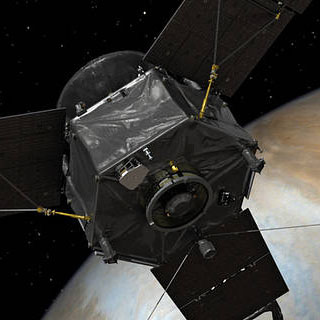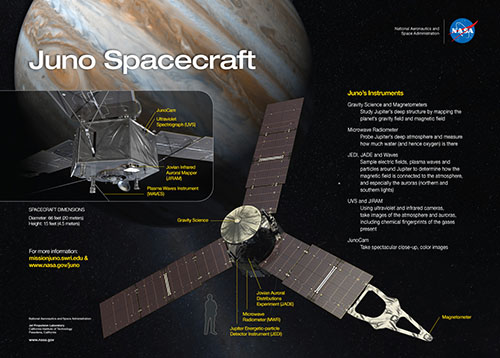Juno
This spacecraft launched into space in 2016, powered by solar energy and the size of a basketball court, makes long orbits around the giant planet Jupiter. Their instruments obtain data by penetrating the planet's dense clouds, revealing a variety of secrets that lie within, how Jupiter came to be, its deep structure and its evolution over billions of years.
High above Jupiter's roiling clouds, the Juno spacecraft rotates to stay steady while making wide elliptical orbits around it. At the most distant point in these orbits, Juno is far from Jupiter and its moons, in a zone free from the planet's intense radiation. But at the closest point every 53 days, Juno approaches 5,000 kilometers from the upper cloud layer.
Juno achieved approximate global coverage of the giant planet in late 2018, but with approximate resolution; then started a new set of orbits to fill in the details.
Today, thanks to Juno, important scientific discoveries have been made about the Jupiter system. These are the most prominent
Mystery of water
The now-defunct Galileo spacecraft launched a probe into Jupiter's atmosphere in 1995 and found it unexpectedly dry. Did Jupiter's atmosphere have 10 times less water than scientists expected? Juno's response: No. Closer to Jupiter's equator, the water is much more abundant.
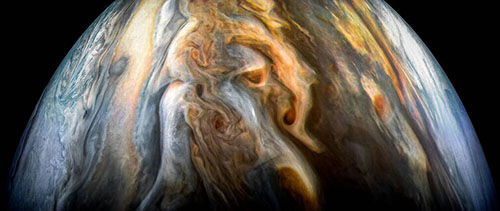
The JunoCam imager aboard NASA's Juno spacecraft captured this image of Jupiter's southern equatorial region on Sept. 1, 2017. The image is oriented so Jupiter's poles (not visible) run left-to-right of frame.
NASA / JPL-Caltech / SwRI / MSSS / Kevin M. Gill
New cyclone
On a close flyby, passing less than 3,500 kilometers above Jupiter's cloud tops, the spacecraft discovered a new giant cyclone at Jupiter's south pole. A pattern of six cyclones, with one in the center, all of which appeared to be fixed in place, but in 2019 there was somehow a new cyclone added to the set.
The sound of lightning
NASA's previous spacecraft, Voyager 1 and 2, Galileo and Cassini, detected lightning strikes in Jupiter's clouds. Unlike Earth’s lightning, Jupiter impacts were detected only at lower radio frequencies. But Juno, probably thanks to its closer approach, also detected lightnings at higher frequencies, solving a 40-year conundrum.
Nine-storm north pole
A central cyclone at Jupiter's north pole is surrounded by eight more, as if bowing in tribute. These cyclones range from 4,000 to 4,600 kilometers wide. Their spiral arms collide with each other as they spin, but the storms don't merge, Juno data shows.

This computer-generated image, based on an infrared image from the JIRAM instrument, shows the structure of the cyclonic pattern observed over Jupiter's north pole: a central cyclone surrounded by eight circumpolar cyclones with diameters ranging from 4,000 to 4,600 km wide.
NASA / JPL-Caltech / SwRI / ASI / INAF / JIRAM
The Great Red Spot in 3D
Perhaps the most iconic storm in the solar system, Jupiter's Great Red Spot has been swirling for centuries. But it appears to have been slowly shrinking, from twice the size of Earth in 1979 to 1.3 times today. Juno probed the depths of the Great Red Spot, showing that its roots are 200 miles deep, 50 to 100 times deeper than Earth's oceans.
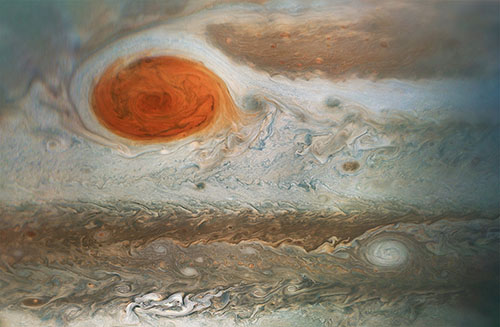
The Red Spot, an ancient storm from Jupiter. This visualization was created from images captured by NASA’s Juno spacecraft, which has been studying Jupiter since it arrived there July 4, 2016.
Enhanced image by Sean Doran (CC BY-NC-SA) based on images provided courtesy of NASA/JPL-Caltech/SwRI/MSSS
Jolts from the poles
High-voltage electrical charges contribute to the formation of auroras at Jupiter's poles, just as they do on Earth. But on Jupiter everything is bigger. The most powerful energies reach 400,000 electron volts, while our most powerful auroras on Earth reach only a few thousand volts.
Swarms of storms
At the top of the spectacular discoveries by JunoCam, which takes pictures in visible light, clusters of storms the size of Earth are found at both poles of Jupiter.
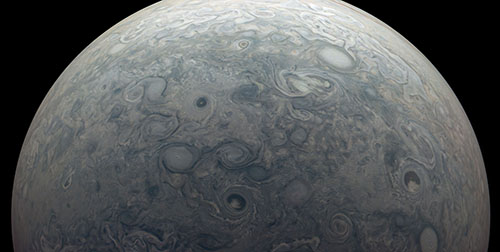
This image from NASA’s Juno mission captures the northern hemisphere of Jupiter around the region known as Jet N7. The planet’s strong winds create the many swirling storms visible near the top of its atmosphere. Data from Juno helped scientists discover another, less visible effect of those winds: Jupiter’s powerful magnetic field changes over time.
NASA/JPL-Caltech/SwRI/MSSS
Outstanding in its field
Scientists knew that Jupiter had an intense magnetic field. Juno proved that it is much more intense than anyone expected, and more rugged. This field is 10 times stronger than the strongest on Earth, according to Juno's magnetometer investigation instrument.
Jupiter’s beltways
The cloud bands, or belts and zones, that we can see from Earth actually have an intricate structure. Near the equator, they penetrate the deepest parts of Jupiter's atmosphere. But as you get closer to the poles, these belts tend to change shape to other structures.
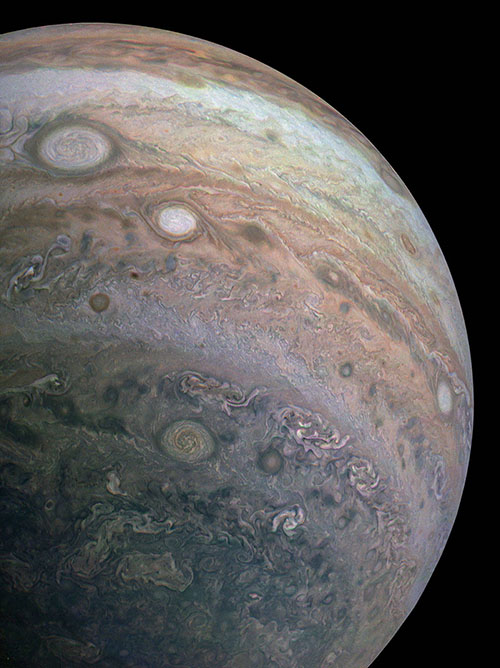
This enhanced-color image from NASA’s Juno spacecraft captures the striking cloud bands of Jupiter’s southern latitudes. Jupiter is not only the largest planet in the solar system, it also rotates at the fastest rate, completing a full day in just 10 hours. This rapid spinning creates strong jet streams, separating Jupiter’s clouds into bright zones and dark belts that wrap around the planet.
NASA/JPL-Caltech/SwRI/MSSS
First close look at the North Pole
As Juno moved into its polar orbit around Jupiter, JunoCam provided the first clear close-up images of the north pole, a strange, bluish region filled with giant storms and strange weather. Unlike Saturn, Jupiter does not show a strange hexagonal jet stream at its north pole.
| Some Juno data | |
| Nation | USA |
| Objective(s) | Jupiter orbit |
| Spacecraft | Juno |
| Spacecraft Mass | 3,625 kg |
| Mission Design and Management | NASA / JPL-Caltech |
| Launch | 08/05/2011 | 16:25 UT |
| Launch Vehicle | Atlas V 551 (AV-029) |
| Launch Site | Cape Canaveral Air Force Station, Fla. |
| Jupiter Orbit Insertion | 07/05/2016 | 03:53 UT |

